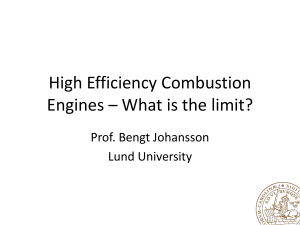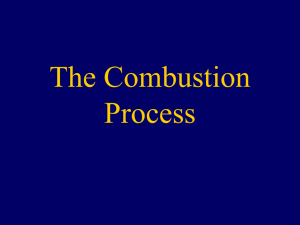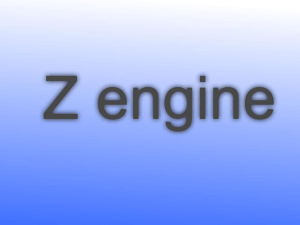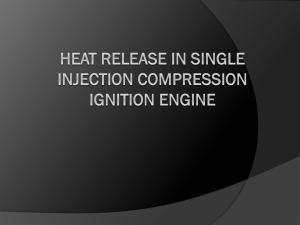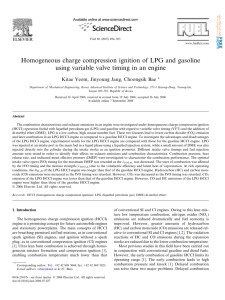Attach 2: Final report template
advertisement
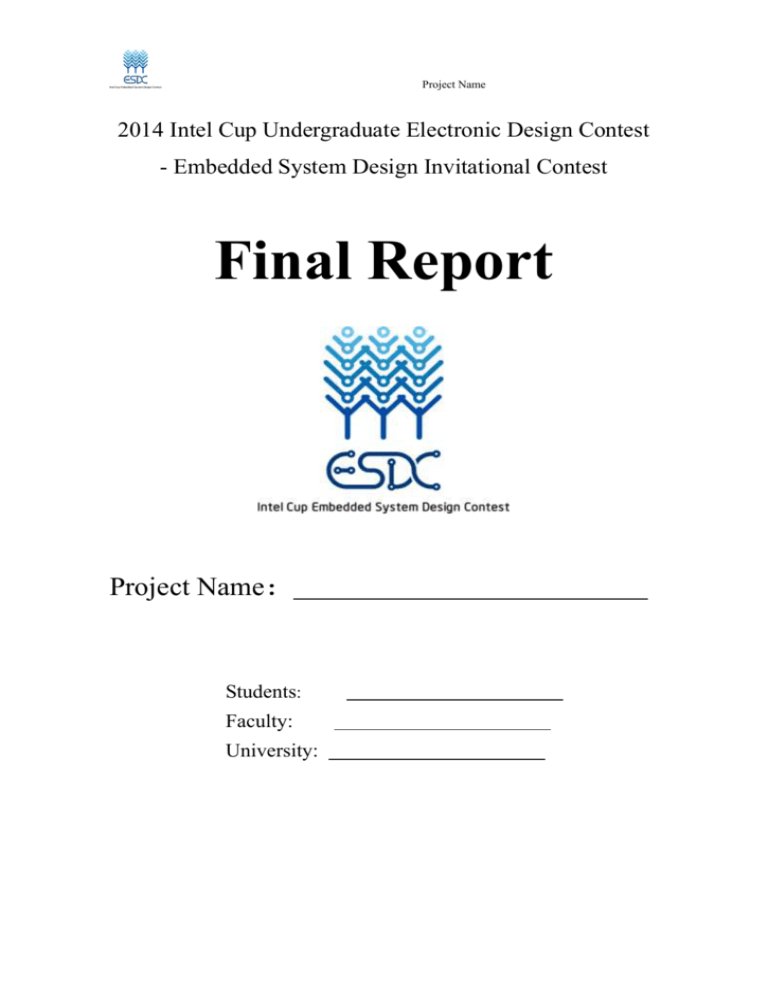
Project Name 2014 Intel Cup Undergraduate Electronic Design Contest - Embedded System Design Invitational Contest Final Report Project Name: Students: Faculty: University: Project Name 2014 Intel Cup Undergraduate Electronic Design Contest - Embedded System Design Invitational Contest Declaration of Originality We hereby declare that this thesis and the work reported herein was composed and originated entirely by ourselves. Information derived from the published and unpublished work of others has been acknowledged in the text and a list of references is given in the references. Team Members Signature: _____________________________________ Name (in Block Letters): Date: Project Name NUMERICAL SIMULATION OF HOMOGENEOUS CHARGE COMPRESSION IGNITION COMBUSTION FUELED WITH DIMETHYL ETHER ABSTRACT HCCI (Homogenous Charge Compression Ignition) combustion has advantages in terms of efficiency and reduced emission. HCCI combustion can not only ensure both the high economic and dynamic quality of the engine, but also efficiently reduce the NOx and smoke emission. Moreover, one of the remarkable characteristics of HCCI combustion is that the ignition and combustion process are controlled by the chemical kinetics, so the HCCI ignition time can vary significantly with the changes of engine configuration parameters and operating conditions. In this work numerical scheme for the ignition and combustion process of DME homogeneous charge compression ignition is studied. The detailed reaction mechanism of DME proposed by American Lawrence Livermore National Laboratory (LLNL) and the HCT chemical kinetics code developed by LLNL are used to investigate the ignition and combustion processes of an HCCI engine fueled with DME. The new kinetic mechanism for DME consists of 79 species and 399 reactions. To consider the effect of wall heat transfer, a wall heat transfer model is added into the HCT code. By this method, the effects of the compression ratio, the fuel-air equivalence ratio, the intake charge heating, the engine speed, EGR and fuel additive on the HCCI ignition and combustion are studied. The results show that the HCCI combustion fueled with DME consists of a low temperature reaction heat release period and a high temperature reaction heat release period. It is also founded that increasing the compression ration, the equivalence ratio, the intake charge temperature and the content of H2O2, H2 or CO cause advanced ignition timing. Increasing the engine speed, adoption of cold EGR and the content of CH4 or CH3OH will delay the ignition timing. Key words: HCCI, chemical kinetics, numerical simulation, DME, EGR Project Name Content Project Name Chapter 1 Introduction HCCI (Homogenous Charge Compression Ignition) combustion has advantages in terms of efficiency and reduced emission. HCCI combustion can not only ensure both the high economic and dynamic quality of the engine, but also efficiently reduce the NOx and smoke emission. Moreover, one of the remarkable characteristics of HCCI combustion is that the ignition and combustion process are controlled by the chemical kinetics, so the HCCI ignition time can vary significantly with the changes of engine configuration parameters and operating conditions. In this work numerical scheme for the ignition and combustion process of DME homogeneous charge compression ignition is studied. The detailed reaction mechanism of DME proposed by American Lawrence Livermore National Laboratory (LLNL) and the HCT chemical kinetics code developed by LLNL are used to investigate the ignition and combustion processes of an HCCI engine fueled with DME. The new kinetic mechanism for DME consists of 79 species and 399 reactions. To consider the effect of wall heat transfer, a wall heat transfer model is added into the HCT code. By this method, the effects of the compression ratio, the fuel-air equivalence ratio, the intake charge heating, the engine speed, EGR and fuel additive on the HCCI ignition and combustion are studied. The results show that the HCCI combustion fueled with DME consists of a low temperature reaction heat release period and a high temperature reaction heat release period. It is also founded that increasing the compression ration, the equivalence ratio, the intake charge temperature and the content of H2O2, H2 or CO cause advanced ignition timing. Increasing the engine speed, adoption of cold EGR and the content of CH4 or CH3OH will delay the ignition timing. 1.1 Introduction HCCI (Homogenous Charge Compression Ignition) combustion has advantages in terms of efficiency and reduced emission. HCCI combustion can not only ensure both the high economic and dynamic quality of the engine, but also efficiently reduce the NOx and smoke emission. 1.1.1 Introduction HCCI (Homogenous Charge Compression Ignition) combustion has advantages in terms of efficiency and reduced emission. HCCI combustion can not only ensure both the high economic and dynamic quality of the engine, but also efficiently reduce the NOx and smoke emission.: (1) Introduction ………………………………………………………………… (2)Introduction ………………………………………………………………… (3)Introduction ………………………………………………………………… 1 (6) Project Name Chapter 2 Introduction 2.1Introduction … 2.1.1 Introduction … K m mk (2-1) k 1 (2-2) Table 2-1 Table Item Hf(kcal/mol) Sf(kcal/mol) Cp(kcal/mol) A1 A2 A3 100 100 100 2 (6) Project Name Continue table 2-1 Item Hf(kcal/mol) Sf(kcal/mol) Cp(kcal/mol) A4 A5 A6 A7 A8 100 100 100 Figure 2-1 caption 3 (6) Project Name Chapter 5 Conclusion … 4 (6) Project Name References [1] World Health Organization. Factors regulating the immune response:report of WHO Scientific Group[R].Geneva:WHO,1970. [2] CHRISTINE M. Plant physiology:plant biology in the Genome Era[J/OL].Science,1998,281: 331-332[1998-09-23].http://www.sciencemag.org/cgi/collection/anatmorp. 5 (6) Project Name

